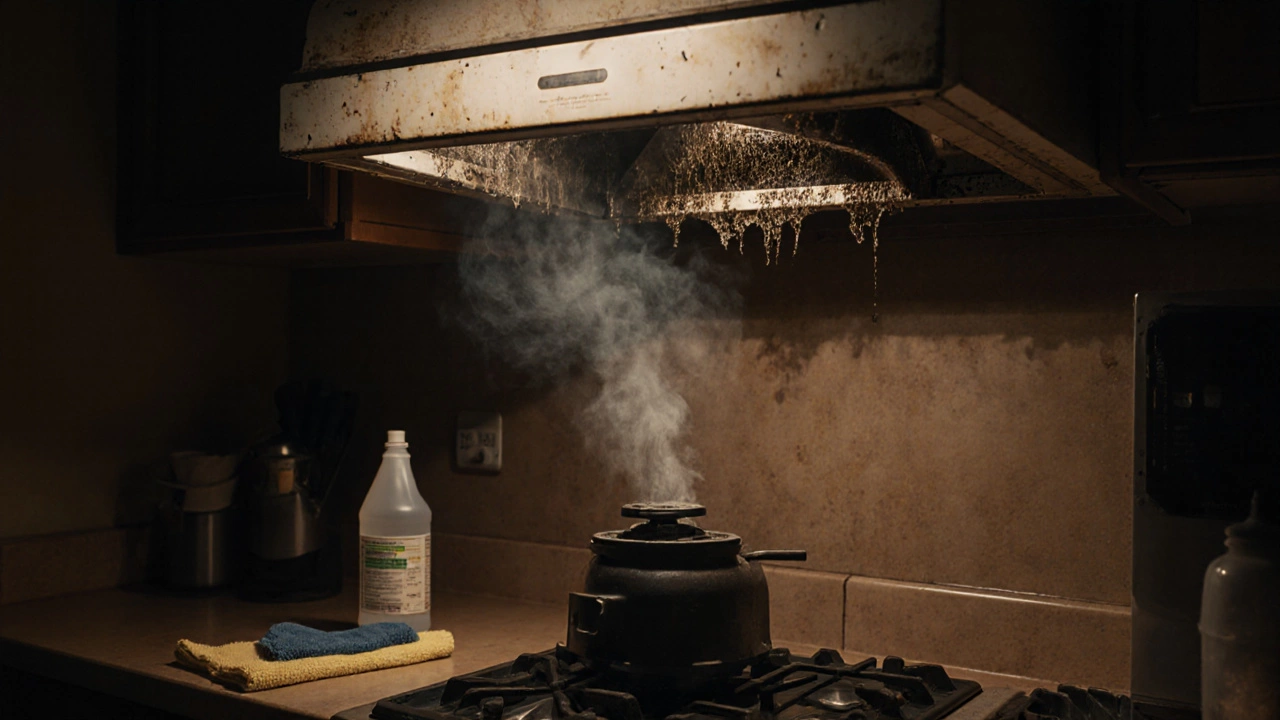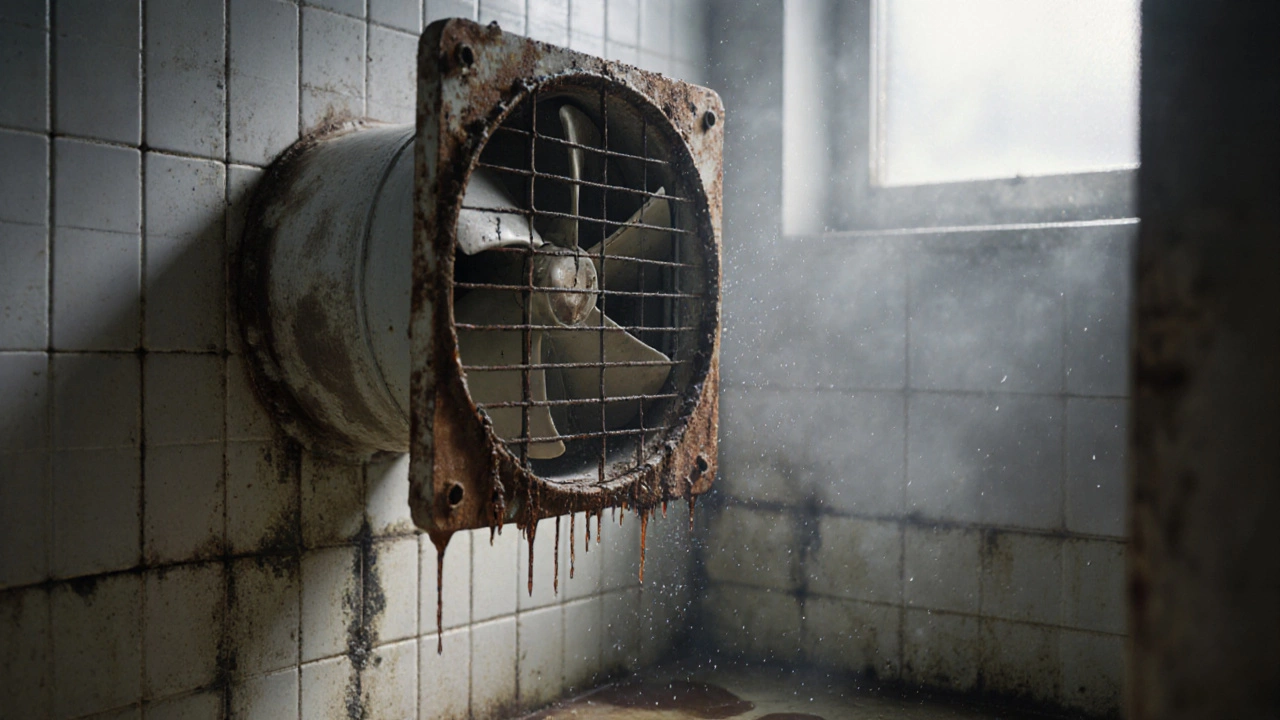Extractor Fan CFM Calculator
To calculate the proper CFM for your extractor fan, enter the room type and dimensions. This tool helps you determine the minimum ventilation required based on room size.
Calculate Your Ventilation Needs
Results
Most people don’t think about their extractor fan until it stops working. Then suddenly, steam lingers in the bathroom, grease coats the kitchen ceiling, and mildew starts creeping into the corners. You wonder: how long do extractor fans last? The answer isn’t simple. It depends on the brand, the environment, how often it runs, and whether it’s been cleaned. But here’s the truth: many extractor fans die way before they should - not because they’re broken, but because they were ignored.
What’s the average lifespan of an extractor fan?
In ideal conditions, a good-quality extractor fan can last between 10 and 15 years. That’s the number you’ll see on manufacturer specs. But in real homes - especially in places like Brisbane with humid summers and frequent cooking - most fans start struggling after 6 to 8 years. I’ve seen cheap bathroom fans fail in under three years because they were installed above a shower without proper sealing. Kitchen fans last longer if they’re cleaned regularly, but if grease builds up inside the motor, even the best fan will burn out early.
There’s a big difference between a $50 fan from a hardware store and a $200 commercial-grade model. The cheaper ones use plastic bearings and thin copper windings. They’re designed to last just long enough to get you through the warranty period. The pricier ones have metal bearings, sealed motors, and thermal overload protection. They’re built to handle daily use. If you’re replacing a fan, don’t just match the old one. Match the quality.
Signs your extractor fan is nearing the end
You don’t need to wait for total silence to know your fan is dying. Here are the real warning signs I see every week in Brisbane homes:
- Noisy operation - Grinding, rattling, or high-pitched whining means the bearings are worn. A little hum is normal. Anything louder than a fridge is a red flag.
- Weak airflow - If your shower stays foggy for 20 minutes after you get out, or your kitchen hood can’t clear smoke from a quick stir-fry, the motor’s losing power.
- Intermittent operation - The fan turns on, runs for a few minutes, then shuts off. That’s usually a failing capacitor or overheating motor.
- Visible rust or corrosion - Especially in bathroom fans. Moisture gets inside, metal parts start to eat away. Even if the motor still spins, the housing is crumbling.
- Smell of burning - Not smoke, but a sharp, hot-oil odor. That’s insulation breaking down on the windings. Turn it off immediately.
One of my clients called me because her fan made a noise like a dying bird. She thought it was just old. When I opened it up, the motor shaft was rusted solid. The housing had cracked from moisture. Replacing it was the only option.
What kills extractor fans faster?
It’s not age that kills these fans - it’s neglect. Here are the top three killers I’ve seen:
- Grease buildup - In kitchens, grease doesn’t just stick to the grille. It coats the impeller, clogs the vents, and hardens inside the motor housing. Over time, the motor has to work harder. It overheats. It burns out. Clean the grille every month. Wipe the blades every six months. Use vinegar and hot water - no harsh chemicals.
- Moisture exposure - Bathroom fans aren’t waterproof. They’re moisture-resistant. If water gets into the motor housing - from a leaky seal, poor installation, or a shower spray that hits the fan - corrosion starts. Always use a fan with an IP rating of at least IP44 for bathrooms. And never install one directly over the showerhead.
- Running too long - Some people leave their fans on for hours after cooking or showering. That’s not necessary. A good fan clears moisture in 15 to 20 minutes. Leaving it on all day wears out the motor faster. Use a timer switch. Or better yet, get one with a humidity sensor that turns off automatically.
One homeowner I worked with had a fan that ran 24/7 because he thought it would stop mold. Instead, it burned out in 18 months. He spent $350 replacing it. A $15 timer would’ve saved him $300.

Can you repair an extractor fan or should you replace it?
Most people ask: Can I fix it? The answer is: sometimes. But rarely worth it.
For under $40, you can replace the capacitor, motor bearings, or fan blades. But here’s the catch: those parts are often not sold separately. You need the exact model number. And even if you find them, the labor to disassemble the housing, clean out grease, and reseal everything takes an hour. That’s more than the cost of a new fan.
There’s one exception: if your fan is a high-end model (like an Extract, Vent-A-Hood, or Zehnder) and it’s under 8 years old. Those are worth repairing. But if it’s a generic brand from Bunnings or Amazon - and it’s older than 6 years - just replace it. You’re not saving money. You’re buying time.
And don’t be fooled by “fan repair kits.” They rarely include the motor. They’re just blades and grilles. If the motor’s gone, the kit won’t help.
How to choose a replacement extractor fan
When you’re ready to replace it, here’s what actually matters:
- CFM rating - Don’t guess. Calculate: For bathrooms, multiply square meters by 15. For kitchens, multiply by 20. If your bathroom is 8m², you need at least 120 CFM. Most cheap fans are rated at 80 CFM - they’re underpowered.
- IP rating - Bathroom fans need IP44 minimum. Kitchen fans need IP20. Don’t use a bathroom fan in the kitchen - the grease will clog it.
- Noise level - Look for 30 dB or lower. Anything above 40 dB is annoying. A quiet fan is a fan you’ll actually use.
- Energy efficiency - Look for an Energy Star label or a Class A rating. Older fans use 40-60 watts. New ones use 10-20 watts. That’s $20-$40 saved per year.
- Features - Timer? Humidity sensor? Light? Motion sensor? Pick one that fits your needs. A timer is the cheapest upgrade. A humidity sensor is the smartest.
I’ve installed dozens of fans. The best value for most homes is a 120-150 CFM, IP44-rated, 25-30 dB fan with a 15-minute timer. They cost $80-$120. Last 10+ years. And they actually work.

How to make your new extractor fan last longer
Replacing it isn’t the end. It’s the start of a new cycle. To get 10+ years out of it:
- Wipe the grille every month with a damp cloth.
- Every 6 months, turn off the power, remove the grille, and vacuum out dust and grease.
- Check the ducting every year. Is it kinked? Is it full of lint? A blocked duct makes the fan work twice as hard.
- Don’t use aerosol sprays near the fan. The chemicals eat the plastic and seals.
- If you’re remodeling, make sure the fan is mounted correctly. It needs a slight downward tilt to drain condensation. If it’s flat, water pools inside.
Simple habits like these double the life of most extractor fans. You’re not just fixing a machine. You’re protecting your walls, your ceilings, and your health.
When to call a professional
You don’t need an electrician to replace a fan - if you’re comfortable with basic wiring. But call one if:
- The fan is wired into a switched circuit you don’t understand
- The ducting runs through the roof or wall and looks damaged
- You smell burning or see scorch marks near the wiring
- You’re replacing a fan in a bathroom with no window and no other ventilation
Improper installation causes more failures than bad parts. A fan that’s not sealed properly will leak moisture into your ceiling. A fan with the wrong duct size will be loud and ineffective. Professionals know the building codes. They know what works in humid climates. And they’ll make sure it’s done right the first time.
How long does a bathroom extractor fan last?
A bathroom extractor fan typically lasts 6 to 10 years, depending on humidity levels, usage, and maintenance. In high-moisture areas like Brisbane, fans exposed to steam without proper sealing often fail in 4 to 6 years. Regular cleaning and correct installation can extend life to 10+ years.
Can extractor fans be repaired?
Yes, but it’s rarely cost-effective. Simple fixes like replacing a capacitor or fan blades are possible for under $40. However, most cheap fans don’t sell individual parts, and labor costs often exceed the price of a new unit. High-end models over 8 years old are worth repairing. Budget fans older than 6 years should be replaced.
Why does my extractor fan keep turning off?
This usually means the motor is overheating. Common causes include grease buildup blocking airflow, a failing capacitor, or poor ventilation in the duct. If the fan runs for 10-15 minutes then shuts off, clean the blades and grille first. If it still happens, the motor or capacitor needs replacing - or it’s time for a new fan.
How do I know if my extractor fan is powerful enough?
Calculate the required airflow: For bathrooms, multiply the room’s square meters by 15. For kitchens, multiply by 20. So an 8m² bathroom needs at least 120 CFM. Most cheap fans are rated at 80 CFM - they’re too weak. Look for a fan with 120-150 CFM for reliable performance.
Is it better to run an extractor fan continuously?
No. Running a fan 24/7 wears out the motor faster and wastes energy. Most moisture is cleared in 15-20 minutes. Use a timer or humidity sensor to turn it off automatically. Continuous operation is only needed in extreme cases, like after a flood - and even then, it should be monitored.





